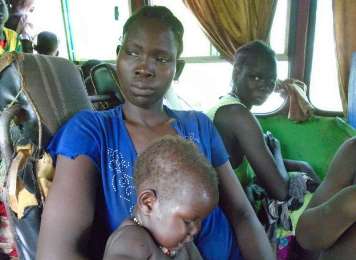UNHCR records sharp decline on South Sudan refuges influx to Ethiopia
By Tesfa-Alem Tekle
January 18, 2016 (ADDIS ABABA) – The number of South Sudan refugees crossing borders to Ethiopia has saw a sharp decline during the recent weeks, a UN refugee agency office in Ethiopia disclosed.

“The new arrivals cross thorough Pagak, Burbie, Akobo or Raad entry points which remain active to this date” UNHCR said in a statement it extended to Sudan Tribune on Saturday.
A few others have crossed via Ethiopia’s Benishangul-Gumuz Region which borders Sudan.
The decline was observed after the two South Sudan warring factions (SPLM-Juba faction and SPLM-IO) begin implementation of the Compromised Peace Agreement signed last August aimed to end two-year long conflict in the youngest nation.
Till January 10, the total numbers of new arrivals from South Sudan since eruption of the conflict in 15 December 2013 has reached 226,473; of these 221,280 are being sheltered at a number of camps in Gambella region bordering South Sudan.
The remaining over 5,000 South Sudan Refugees are sheltered at the Benishangul-Gumuz region where UNHCR mainly accommodates Sudanese refugees.
According to the UN refugees agency 71% of the adult South Sudanese refugee population are women and girls and 68% are children.
As at the end of the reporting period, the cumulative number of the South Sudanese refugees in Ethiopia is 281,205 which includes 54,473 refugees that were in country pre-December 2013.
During the reporting period, 146 refugees belonging to 66 families were inactivated in Pugnido refugee camp after missing three consecutive food distribution cycles as per the continuous registration standard operating procedures.
UNHCR said it had recently convened a joint monitoring team comprising Oxfam, DRC (Danish Refugee Council) and LWF (Lutheran World Federation) to provide technical inputs to the ongoing works on the permanent water supply system for Jewi camp.
The team visited the intake works along the Baro River and the treatment plant and agreed on changes to be made on the works.
The joint team also certified the 3 kilometres welded pressure mains from reservoir sites 1 and 2 and gave the go ahead for DRC to make minor corrections before back-filling the pipeline.
In Pugnido refugee camp, International Medical Corp (IMC) conducted home to home visits and awareness sessions for a total of 585 refugee women and girls on types of Sexual and Gender-based Violence (SGBV), causes, consequences and referral pathways for SGBV survivors.
“The session is expected to help create better understanding for the beneficiaries to help protect themselves and others in the camp” it said.
UNCHR in collaboration with other aid agencies has also undertook a number of humanitarian activities including provision of artificial leg shoe-fitting to South Sudan Refugees with leg disabilities.
In Pugnido camp, Save the Children International (SCI) delivered some essential aid items including blankets, spoons, bed sheets, plates, and laundry soap to 150 Separated children at the ‘New Extension Site’.
Some 1,900 South Sudanese children including 900 girls have also participated in child-friendly activities in Child friendly spaces in Jewi Refugee Camp.
Save the Children has also provided educational materials used for Early Childhood Care and Education (ECCE) School in Tierkidi Camp.
The first round of Enhanced Outreach Strategy for Child Survival Intervention (EOC) campaign by the Administration for Refugee and Returnee Affairs (ARRA) and the Regional Health Bureau was concluded in Pugnido, Pugnido 2, Jewi, and Okugo refugee camps.
The campaign has continues in both Tierkidi and Kule refugee camps from 11 January.
“A total of 29,294 children aged 6-59months and 6,123 pregnant and lactating women are targeted for the campaign in all refugee locations” UNHCR said.
Mass Meningitis vaccinations Campaign were also conducted in Kule and Tierkidi refugee camps.
Although the decline in influx could be seen as a sign of improved security however many South Sudanese refugees here in Ethiopia fear that lack of full commitment from both rival parties to implement the peace deal might lead to a renewed violence.
Refugees told Sudan Tribune that they are eager to return home and reunite with their families.
However they are reluctant to return home and say they should rather stay in camps until sustainable peace and security is restored in the country.
The conflict in South Sudan erupted in mid-December 2013 between forces loyal to Kiir and those backing former Vice President Machar.
The violence which quickly spread across the country killed tens of thousands of people and forced an estimated two million flee their homes.
(ST)
